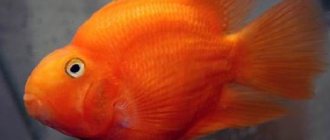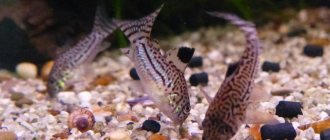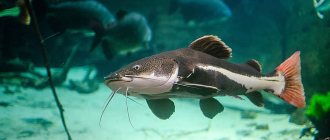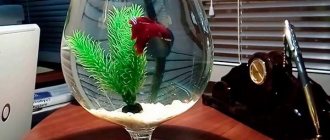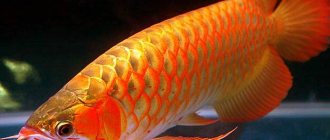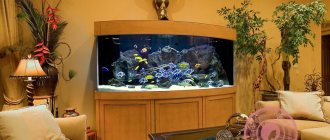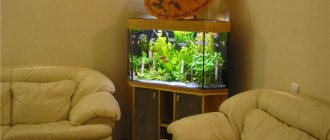10/02/2019Pisces0
Parrotfish is from the ray-finned family; more than 100 species are classified. She has a colorful coloring and a peculiar head shape, similar to a bird's beak. The aquarium fish was developed in Taiwan by crossing Cichlases, different species of American cichlids. Breeders still keep the details of their work secret.
It appeared in Russia at the end of the last century. Due to its unpretentiousness and unusual appearance, it is in demand among beginners and experienced breeders.
- 1 Description and natural habitat
- 2 Mr. Tail recommends: variety of species and color
- 3 Basics of aquarium keeping
- 4 Compatibility
- 5 Feeding
- 6 Breeding
- 7 Diseases and prevention
- 8 Interesting facts about the Parrot fish
Description and natural habitat
Marine Parrotfish live in the coastal waters of the Gulf of Mexico and the Caribbean Islands, the Indian and Pacific Oceans at depths of 2-20 m. Forming small schools, they occupy a territory that is comfortable for themselves and drive away those who try to penetrate it. Life expectancy is about 10 years.
They are hermaphrodites, they are female for half their life, then they change sex. They lead a diurnal lifestyle. Fish are omnivores, feeding on oysters, mussels, snails, and algae.
Freshwater Parrots in an aquarium grow up to 20-30 cm, their life expectancy is 7 years.
They are distinguished by a very small mouth, large lips that do not close completely. Teeth fused to the jaw. The dorsal and pelvic fins are triangular, reminiscent of the wings of a parrot, their bases are parallel to each other, small. The body is short, side-shaped, bright in color. The spine and swim bladder are deformed and curved, which affects swimming ability. The nose is like a bird's beak. Fangs and incisors protrude outward.
Photo gallery of Parrot Fish:
During the spawning period, males lure females to secluded places where they spawn. The male fertilizes the larvae floating in the water. The female is able to change sex and perform male functions.
What does it look like
In most cases, parrotfish have a bright red or orange color. It happens that the color becomes faded, to correct this, you should include carotene in the diet, and the color will become bright again. In rare cases, there are also albino parrots, whose color is white or pale yellow. They acquired other unusual colors (pink, blue, green) thanks to artificial dyeing. But after a while it starts to wash off. Also, parrot fish can have not only a solid color, but also a variegated, spotted one - it is present in the panda parrot (Panda Parrot), marbled parrot, diamond and pearl parrot (Killin Parrot).
Mr. Tail recommends: variety of species and colors
There are many types and colors of fish. The most common:
- Red is a hybrid, not found in nature, obtained by crossing. Reaches 25 cm, scales are red-orange. Beak with sharp fangs and incisors. Changes color several times as it matures. Calm, peaceful.
- Scar - dwarf up to 20 cm, large up to 100 cm, they have many varieties, for example - dark, striped-bellied, Red Sea, guacamaya.
- Common - up to 10 cm, silver-blue in color, with a golden stripe along the back. The dorsal and anal fins are pointed.
- Green Boneface (Japanese) is a large, aggressive species. Reaches 100 cm in nature and can live up to 40 years.
- Pearl - up to 15 cm, no deviations in appearance. Body color is olive, orange, brown with small white spots.
- Blue – reaches 70 cm, bright blue color, distinguished by a large jaw and powerful fangs.
Parrotfish are also distinguished by the shape of their fins and bodies:
- King Kong has large fins and a layer of fat on the forehead.
- Red ingot - the body looks like a disk.
- Red Fortune - a huge beak-like growth, long fins.
- Love Heart – Rear fin missing.
- Unicorn - there is a seal on the head that looks like a horn.
- Diamond – up to 20 cm. Adult males with a hump on the head.
The colors of Parrots include lemon, yellow, blue, purple, black, marbled, white with black spots. Sometimes breeders, in order to get two-color fish, artificially color it, even apply tattoos, but this leads to great stress and early death of the individual.
Best neighbors
Red Parrots are clumsy and calm creatures. They get along well with equally friendly neighbors. For example, they look great with:
peaceful species of cichlids: lemon labidochromis, black-striped cichlazoma, cichlazoma meeca, severum, distichodus:
large tetras, metinis, sharks, European loach, angelfish and dollar fish;
barbs: shark barbs, denison barbs, Sumatran barbs, bream barbs, Congo barbs;
catfish-like species: glass catfish, ancitrus, corydoras, plecostomus, thoracatum.
The Red Parrot is a very peaceful and intelligent creature. This species gets used to its owner and recognizes him. When bored or greeted, the fish swim closer to the owner, watch him through the glass and even allow themselves to be stroked.
You should not put Red Parrots and small fish together, such as Mexican guppies, blue neons, small tetras. Such fish become easy prey for large Parrots.
Aquarium Basics
Parrots are unpretentious, tolerate temperature changes, and rarely get sick. But certain conditions must be observed to maintain them at home. The fish tank should be large, at least 150 liters. The aquarium is maintained at: water temperature - +26...+28 °C, hardness - 2-25 dh, acidity - 6.5-7.5 pH, nitrates no more than 30 mg/l. You need a pump for artificial flow, a compressor, a filter. The presence of ammonia and ammonium is unacceptable.
Maintenance is simple, the main thing is to regularly filter the water and ensure aeration. Lighting should be moderate, dim; if the color of the individuals is too bright, it will become lighter. Plants are placed on the sides, in the background. Parrots love snags and grottoes. They prefer to hide there; each individual should have its own shelter. A lid and a net are installed on top to prevent pets from jumping out. The soil should be made of small smooth pebbles and sand. Change the water every week by 20-30%.
Parrotfish are energetic, over time they recognize their owners, often become attached to him, wait, meet him, and allow themselves to be stroked. During stress or fear, they lose color.
Aquarium equipment
Parrots love running, flowing water. Therefore, the aquarium must have special equipment for aeration and simulating water flows. Then the kids will feel comfortable and freely frolic in the streams of water.
The equipment set must include the following required elements:
- Special pump for simulating underwater flows.
- Aeration equipment.
- There must be a lid for the aquarium so that moving fish do not jump out.
- Parrots do not need excessive decoration; they love space and clean water.
Only if the listed requirements are met, the health of the parrot fish will be at a high level.
Feeding
Due to the small mouth, not all food is suitable for Parrot Fish. They leave a lot of waste behind, and the aquarium has to be cleaned more often. Ready-made flakes, granules, and tablets for fish are recommended as food. Also, individuals will not refuse bloodworms, brine shrimp, shrimp, and worms.
To prevent the fish from losing their bright colors, they are given vegetables containing beta-carotene and protein (zucchini, bell peppers, lettuce). They are fed in small portions, twice a day; individuals should not eat too much to avoid obesity; they have a fasting day once a week.
Compatibility with other fish
Parrots get along well with fish:
- Catfish.
- Barbs.
- Ostronotuses.
- Aquarium arowanas.
- Black knives.
- Cichlids.
But fish smaller than 5 cm are not compatible with parrots; they can accidentally feed on them.
And also fish that feed on algae. For example, angelfish, because aquarium parrots make shelter from algae.
Breeding
It is impossible to distinguish males from females until 1.5 years of age. Males are larger, brighter, and their fins are pointed.
Unfortunately, most males of such hybrids are sterile and it is impossible to produce offspring. However, having reached maturity, they prepare for reproduction, having found a mate, the fish begin mating games. They dig a hole where the female lays her eggs, the parents guard the eggs. But it remains unfertilized and dies over time. If there are males of closely related fish in the aquarium, they are able to fertilize the eggs.
In this case, the fry are gray-black for up to 5 months. Then they turn bright orange. Parents feed their offspring by grinding pieces of food in their mouths and spitting out the suspension. You can also give young animals special liquid food.
Nutrition
As for the nutrition of these amazing fish, they are absolutely not picky in this matter. They have an excellent appetite. Therefore, those who decide to buy a Parrot fish must simultaneously purchase food for their new pet.
Their diet includes dry and live food; they absorb everything with great pleasure. Fish love bloodworms, tubifex, and shrimp. Their menu must include plant foods. The older the fish gets, the more its appearance loses its bright colors. You can support the variegation of Parrots with the help of carotene or shrimp.
Residues of food must be removed from the aquarium to help keep it properly clean. You should not overfeed your fish; it is better to accustom them to three meals a day.
Diseases and prevention
Parrots are generally disease resistant. But in dirty water, with an excessive number of inhabitants in the aquarium, the fish can get sick.
Black spots appear against the background of stress - reasons: poor presence of nitrites. Change the liquid in the aquarium and wash the soil.
The presence of white-transparent, thread-like excrement, lethargy, loss of appetite, and erosion on the head indicate the appearance of hexamitosis. Sick individuals are removed. Metronidazole, Furazolidone, Kanamycin, Ciprofloxacin are used after consultation with a veterinarian.
White spots that look like semolina indicate ichthyophthyriasis. The soil is siphoned, the filters are washed, and the individuals are fed less. Sulfur costapur is used in treatment - a special medicine, it is administered at night, the water is changed by 30%, the temperature is raised by 2 degrees.
If the fish is at the bottom, it means it has been poisoned or overeaten. The individual is removed and methylene blue is injected. Use Kanamycin, Metranidazole.
To prevent diseases, it is necessary to feed the fish only high-quality food, do not give food in excess, and add vegetables. Change the water periodically, filter it and do not overcrowd the aquarium.
Interesting facts about the Parrot fish
The Marine Parrot Fish, which lives naturally in the Red Sea, the Mediterranean Sea, and the tropics, feeds on coral polyps and reaches a meter in length.
Before going to bed, individuals secrete mucus, it contains antibacterial substances, and it envelops the body. Thus, the created shell hides the smell from predators and protects against parasites. At dawn, the fish gnaw through the cocoon they have made and go in search of food.
At high tide, they enter lagoons, where they bite off their favorite delicacies - coral polyps - with strong jaws. In the pharynx, food is digested into fine dust. The fish cleans the coral of dead rocks, which it turns into sand.
Its meat is delicious, fishermen use all means to hunt the Sea Parrot, but catching it is prohibited in order to preserve coral reefs.
